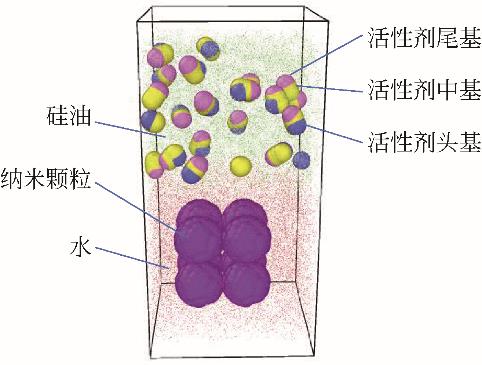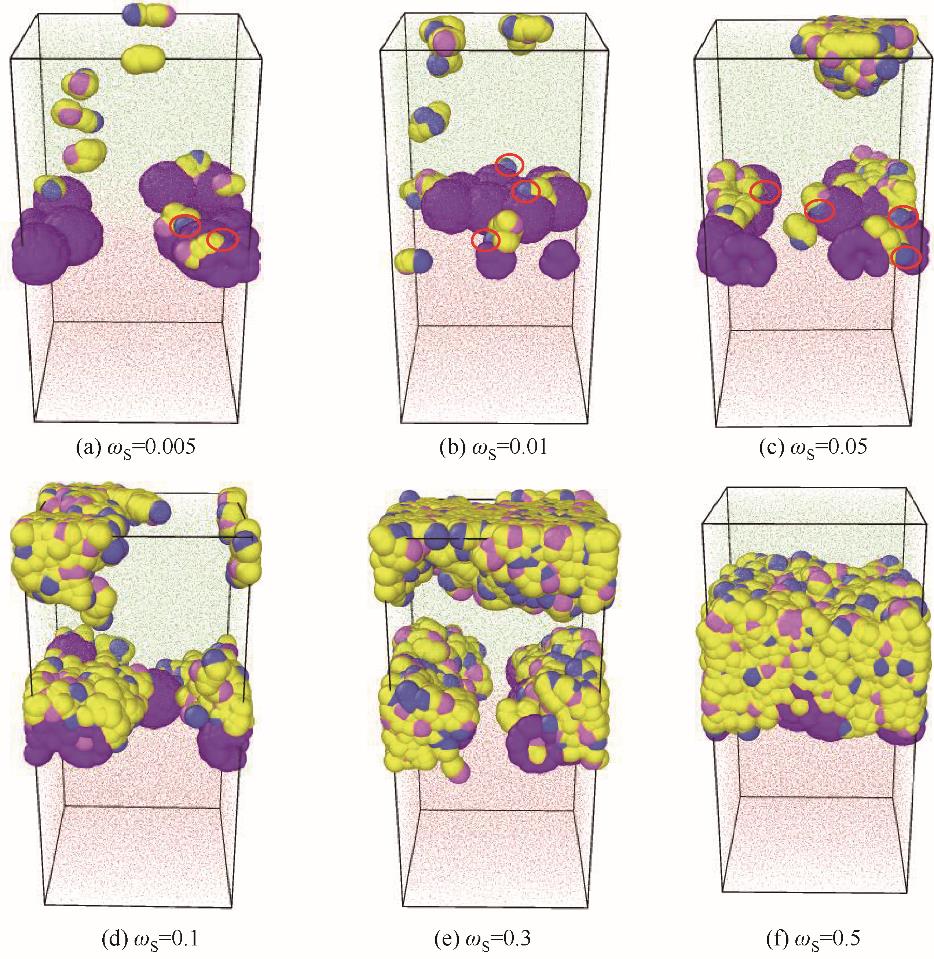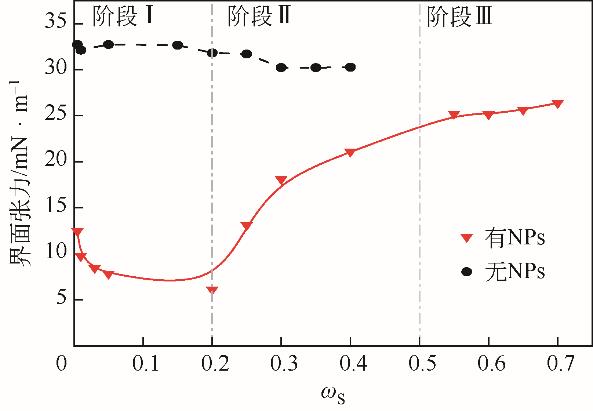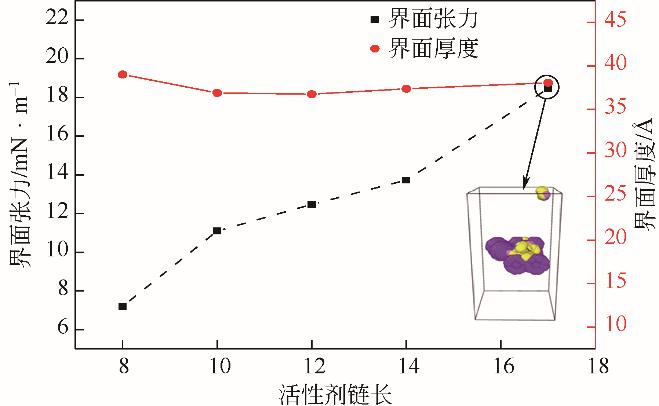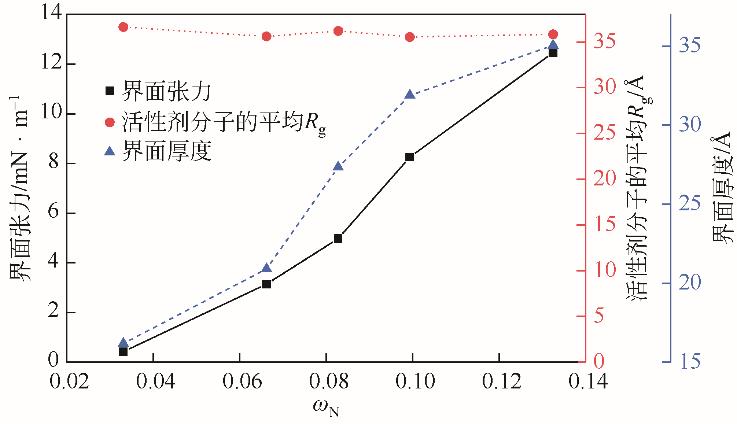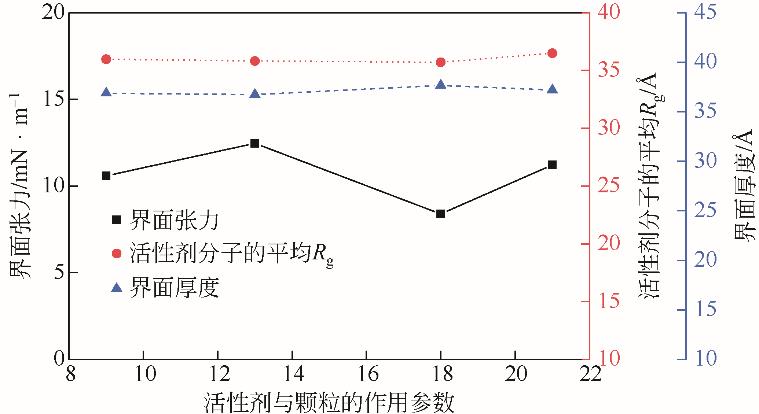Chemical Industry and Engineering Progress ›› 2022, Vol. 41 ›› Issue (S1): 366-375.DOI: 10.16085/j.issn.1000-6613.2021-2450
• Materials science and technology • Previous Articles Next Articles
Molecular dynamics study on the influence of self-assembly behaviors of nanoparticles and surfactants on the properties of silicone oil/water interface
SONG Chao( ), YE Xuemin, LI Chunxi(
), YE Xuemin, LI Chunxi( )
)
- Hebei Key Laboratory of Low Carbon and High Efficiency Power Generation Technology, North China Electric Power University, Baoding 071003, Hebei, China
-
Received:2021-11-29Revised:2022-01-03Online:2022-11-10Published:2022-10-20 -
Contact:LI Chunxi
纳米颗粒与表面活性剂的自组装行为对硅油-水界面性质影响的分子动力学
- 华北电力大学河北省低碳高效发电技术重点实验室,河北 保定 071003
-
通讯作者:李春曦 -
作者简介:宋超(1997—),男,硕士研究生,研究方向为界面现象的分子动力学模拟。E-mail:songchao19970120@163.com。
CLC Number:
Cite this article
SONG Chao, YE Xuemin, LI Chunxi. Molecular dynamics study on the influence of self-assembly behaviors of nanoparticles and surfactants on the properties of silicone oil/water interface[J]. Chemical Industry and Engineering Progress, 2022, 41(S1): 366-375.
宋超, 叶学民, 李春曦. 纳米颗粒与表面活性剂的自组装行为对硅油-水界面性质影响的分子动力学[J]. 化工进展, 2022, 41(S1): 366-375.
share this article
Add to citation manager EndNote|Ris|BibTeX
URL: https://hgjz.cip.com.cn/EN/10.16085/j.issn.1000-6613.2021-2450
| 项目 | 水 | 活性剂头基 | 活性剂中基 | 活性剂尾基 | 油头基 | 油尾基 | 纳米 颗粒 |
|---|---|---|---|---|---|---|---|
| 水 | 25 | ||||||
| 活性剂头基 | 27.9 | 25 | |||||
| 活性剂中基 | 39.2 | 27.3 | 25 | ||||
| 活性剂尾基 | 39.3 | 27.1 | 27.8 | 25 | |||
| 油头基 | 39.7 | 27.6 | 30 | 31 | 25 | ||
| 油尾基 | 39.2 | 27.3 | 35.8 | 35.8 | 27.3 | 25 | |
| 纳米颗粒 | 30.7 | 13 | 35.3 | 30.2 | 35.9 | 38.3 | 25 |
| 项目 | 水 | 活性剂头基 | 活性剂中基 | 活性剂尾基 | 油头基 | 油尾基 | 纳米 颗粒 |
|---|---|---|---|---|---|---|---|
| 水 | 25 | ||||||
| 活性剂头基 | 27.9 | 25 | |||||
| 活性剂中基 | 39.2 | 27.3 | 25 | ||||
| 活性剂尾基 | 39.3 | 27.1 | 27.8 | 25 | |||
| 油头基 | 39.7 | 27.6 | 30 | 31 | 25 | ||
| 油尾基 | 39.2 | 27.3 | 35.8 | 35.8 | 27.3 | 25 | |
| 纳米颗粒 | 30.7 | 13 | 35.3 | 30.2 | 35.9 | 38.3 | 25 |
| 盒子大小 | 界面张力/mN·m-1 | 界面张力变化率/% |
|---|---|---|
| 10×10×20 | 30.94 | |
| 15×15×30 | 31.88 | 2.948 |
| 20×20×40 | 32.36 | 1.508 |
| 25×25×50 | 33.01 | 1.971 |
| 盒子大小 | 界面张力/mN·m-1 | 界面张力变化率/% |
|---|---|---|
| 10×10×20 | 30.94 | |
| 15×15×30 | 31.88 | 2.948 |
| 20×20×40 | 32.36 | 1.508 |
| 25×25×50 | 33.01 | 1.971 |
| 1 | CHAI Y, LUKITO A, JIANG Y F, et al. Fine-tuning nanoparticle packing at water–oil interfaces using ionic strength[J]. Nano Letters, 2017, 17(10): 6453-6457. |
| 2 | TOOR A, FORTH J, BOCHNER D A S, et al. Mechanical properties of solidifying assemblies of nanoparticle surfactants at the oil-water interface[J]. Langmuir, 2019, 35(41): 13340-13350. |
| 3 | HUANG C, SUN Z, CUI M, et al. Structured liquids with pH-triggered reconfigurability[J]. Advanced Materials, 2016, 28(31): 6612-6618. |
| 4 | ALASIRI H S, SULTAN A S, CHAPMAN W G. Effect of surfactant headgroup, salts, and temperature on interfacial properties: dissipative particle dynamics and experiment for the water/octane/surfactant system[J]. Energy & Fuels, 2019, 33(7): 6678-6688. |
| 5 | 戴姗姗, 寇子敏, 刘艳, 等. SiO2/聚丙烯酰胺核壳结构复合材料的分子动力学模拟[J]. 化工进展, 2018, 37(9): 3547-3554. |
| DAI S S, KOU Z M, LIU Y, et al. Molecular dynamics simulation of SiO2/PAM composites with a core-shell structure[J]. Chemical Industry and Engineering Progress, 2018, 37(9): 3547-3554. | |
| 6 | 孔令云, 全秀洁, 李朝波, 等. 乳化剂在集料化学成分表面吸附行为的分子模拟与试验论证[J]. 化工进展, 2020, 39(8): 3196-3204. |
| KONG L Y, QUAN X J, LI C B, et al. Molecular simulation and experimental demonstration of adsorption behavior of emulsifier on surface of chemical composition of aggregate[J]. Chemical Industry and Engineering Progress, 2020, 39(8): 3196-3204. | |
| 7 | RANATUNGA R U, NGUYEN C T, WILSON B A, et al. Molecular dynamics study of nanoparticles and non-ionic surfactant at an oil-water interface[J]. Soft Matter, 2011, 7(15): 6942-6952. |
| 8 | LUO M X, DAI L L. Molecular dynamics simulations of surfactant and nanoparticle self-assembly at liquid–liquid interfaces[J]. Journal of Physics: Condensed Matter, 2007, 19(37): 375109-375124. |
| 9 | HOOGERBRUGGE P J, KOELMAN J. Simulating microscopic hydrodynamic phenomena with dissipative particle dynamics[J]. EPL (Europhysics Letters), 1992, 19(3): 155-160. |
| 10 | GROOT R D, WARREN P B. Dissipative particle dynamics: bridging the gap between atomistic and mesoscopic simulation[J]. The Journal of Chemical Physics, 1997, 107(11): 4423-4435. |
| 11 | GROOT R D. Mesoscopic simulation of polymer-surfactant aggregation[J]. Langmuir, 2000, 16(19): 7493-7502. |
| 12 | MÜLLER M, STEINMÜLLER B, DAOULAS K C, et al. Polymer–solid contacts described by soft, coarse-grained models[J]. Physical Chemistry Chemical Physics, 2011, 13(22): 10491-10502. |
| 13 | FIELD M J, BASH P A, KARPLUS M. A combined quantum mechanical and molecular mechanical potential for molecular dynamics simulations[J]. Journal of Computational Chemistry, 1990, 11(6): 700-733. |
| 14 | DONG F L, LI Y, ZHANG P. Mesoscopic simulation study on the orientation of surfactants adsorbed at the liquid/quid interface[J]. Chemical Physics Letters, 2004, 399(1): 215-219. |
| 15 | CALVARESI M, DALLAVALLE M, ZERBETTO F. Wrapping nanotubes with micelles, hemimicelles, and cylindrical micelles[J]. Small, 2009, 5(19): 2191-2198. |
| 16 | YUAN S L, CAI Z T, XU G Y, et al. Mesoscopic simulation study on phase diagram of the system oil/water/aerosol OT[J]. Chemical Physics Letters, 2002, 365(3/4): 347-353. |
| 17 | 李亚娉. 表面活性剂界面行为和构效关系研究[D]. 济南: 山东大学, 2014. |
| LI Y P. Interfacial behaviour and strucyure-function relationship of surfactants[D]. Jinan: Shandong University, 2014. | |
| 18 | FLEISCHER C A, MORALES A R, KOBERSTEIN J T. Interfacial modification through end group complexation in polymer blends[J]. Macromolecules, 1994, 27(2): 379-385. |
| 19 | ROSEN M J, MURPHY D S. Effect of the nonaqueous phase on interfacial properties of surfactants. 2. Individual and mixed nonionic surfactants in hydrocarbon/water systems[J]. Langmuir, 1991, 7(11): 2630-2635. |
| 20 | FLEISCHER C A, KOBERSTEIN J T, KRUKONIS V, et al. The effect of end groups on thermodynamics of immiscible polymer blends. 1. Interfacial tension[J]. Macromolecules, 1993, 26(16): 4172-4178. |
| 21 | VU T V, PAPAVASSILIOU D V. Oil-water interfaces with surfactants: a systematic approach to determine coarse-grained model parameters[J]. The Journal of Chemical Physics, 2018, 148(20): 204704-204716. |
| 22 | 陈小榆, 李原, 谢欣彤, 等. Al2O3纳米颗粒与表面活性剂对O/W乳状液稳定性的影响[J]. 油田化学, 2017, 34(4): 675-679. |
| CHEN X Y, LI Y, XIE X T, et al. Effect of alumina nanoparticle and surfactant on the stability of O/W emulsion [J]. Oilfield Chemistry, 2017, 34(4): 675-679. | |
| 23 | GOODARZI F, ZENDEHBOUDI S. Effects of salt and surfactant on interfacial characteristics of water/oil systems: molecular dynamic simulations and dissipative particle dynamics[J]. Industrial & Engineering Chemistry Research, 2019, 58(20): 8817-8834. |
| 24 | JANG S S, LIN S T, MAITI Prabal K, et al. Molecular dynamics study of a surfactant-mediated decane-water interface: effect of molecular architecture of alkyl benzene sulfonate[J]. The Journal of Physical Chemistry B, 2004, 108(32): 12130-12140. |
| 25 | 高斯萌, 夏坤, 康志红, 等. “拟双子” 阴离子表面活性剂在癸烷/水界面的分子动力学模拟[J]. 化学学报, 2020, 78(2): 155-160. |
| GAO S M, XIA K, KANG Z H, et al. Molecular dynamics simulation of “quasi-gemini” anionic surfactant at the decane/water interface[J]. Acta Chimica Sinica, 2020, 78(2): 155-160. | |
| 26 | ZHANG S H, HAN X Y, TAN Y, et al. Effects of hydrophilicity/lipophilicity of nano-TiO2 on surface tension of TiO2-water nanofluids[J]. Chemical Physics Letters, 2018, 691: 135-140. |
| 27 | 瞿舟. 表面活性剂分子油水界面性质的分子动力学模拟研究[D]. 湘潭: 湘潭大学, 2018. |
| QU Z. The interfacial activities of surfactants at oil/water interface: molecular dynamics simulations[D]. Xiangtan: Xiangtan University, 2018. |
| [1] | ZHANG Zuoqun, GAO Yang, BAI Chaojie, XUE Lixin. Thin-film nanocomposite (TFN) mixed matrix reverse osmosis (MMRO) membranes from secondary interface polymerization containing in situ grown ZIF-8 nano-particles [J]. Chemical Industry and Engineering Progress, 2023, 42(S1): 364-373. |
| [2] | CUI Shoucheng, XU Hongbo, PENG Nan. Simulation analysis of two MOFs materials for O2/He adsorption separation [J]. Chemical Industry and Engineering Progress, 2023, 42(S1): 382-390. |
| [3] | ZHAO Jingchao, TAN Ming. Effect of surfactants on the reduction of industrial saline wastewater by electrodialysis [J]. Chemical Industry and Engineering Progress, 2023, 42(S1): 529-535. |
| [4] | WANG Tai, SU Shuo, LI Shengrui, MA Xiaolong, LIU Chuntao. Dynamic behavior of single bubble attached to the solid wall in the AC electric field [J]. Chemical Industry and Engineering Progress, 2023, 42(S1): 133-141. |
| [5] | WANG Shangbin, OU Hongxiang, XUE Honglai, CAO Haizhen, WANG Junqi, BI Haipu. Effect of xanthan gum and nano silica on the properties of fluorine-free surfactant mixed solution foam [J]. Chemical Industry and Engineering Progress, 2023, 42(9): 4856-4862. |
| [6] | ZHU Chuanqiang, RU Jinbo, SUN Tingting, XIE Xingwang, LI Changming, GAO Shiqiu. Characteristics of selective non-catalytic reduction of NO x with solid polymer denitration agent [J]. Chemical Industry and Engineering Progress, 2023, 42(9): 4939-4946. |
| [7] | XIE Zhiwei, WU Zhangyong, ZHU Qichen, JIANG Jiajun, LIANG Tianxiang, LIU Zhenyang. Viscosity properties and magnetoviscous effects of Ni0.5Zn0.5Fe2O4 vegetable oil-based magnetic fluid [J]. Chemical Industry and Engineering Progress, 2023, 42(7): 3623-3633. |
| [8] | OUYANG Sufang, ZHOU Daowei, HUANG Wei, JIA Feng. Research progress on novel anti-migration rubber antioxidants [J]. Chemical Industry and Engineering Progress, 2023, 42(7): 3708-3719. |
| [9] | LI Ruidong, HUANG Hui, TONG Guohu, WANG Yueshe. Hygroscopic properties and corrosion behavior of ammonium salt in a crude oil distillation column [J]. Chemical Industry and Engineering Progress, 2023, 42(6): 2809-2818. |
| [10] | YANG Yang, SUN Zhigao, LI Cuimin, LI Juan, HUANG Haifeng. Promotion on the formation of HCFC-141b hydrate under static conditions by surfactant OP-13 [J]. Chemical Industry and Engineering Progress, 2023, 42(6): 2854-2859. |
| [11] | CHEN Yixin, ZHEN Yaoyao, CHEN Ruihao, WU Jiwei, PAN Limei, YAO Chong, LUO Jie, LU Chunshan, FENG Feng, WANG Qingtao, ZHANG Qunfeng, LI Xiaonian. Preparation of platinum based nanocatalysts and their recent progress in hydrogenation [J]. Chemical Industry and Engineering Progress, 2023, 42(6): 2904-2915. |
| [12] | DONG Xiaoshan, WANG Jian, LIN Fawei, YAN Beibei, CHEN Guanyi. Exsolved metal nanoparticles on perovskite oxides: exsolution, driving force and control strategy [J]. Chemical Industry and Engineering Progress, 2023, 42(6): 3049-3065. |
| [13] | XU Guobin, LIU Honghao, LI Jie, GUO Jiaqi, WANG Qi. Preparation and properties of ZnO QDs water-based inkjet fluorescent ink [J]. Chemical Industry and Engineering Progress, 2023, 42(6): 3114-3122. |
| [14] | YU Dingyi, LI Yuanyuan, WANG Chenyu, JI Yongsheng. Preparation of lignin-based pH responsive hydrogel and its application in controlled drug release [J]. Chemical Industry and Engineering Progress, 2023, 42(6): 3138-3146. |
| [15] | ZHAO Yi, YANG Zhen, ZHANG Xinwei, WANG Gang, YANG Xuan. Molecular simulation of self-healing behavior of asphalt under different crack damage and healing temperature [J]. Chemical Industry and Engineering Progress, 2023, 42(6): 3147-3156. |
| Viewed | ||||||
|
Full text |
|
|||||
|
Abstract |
|
|||||




